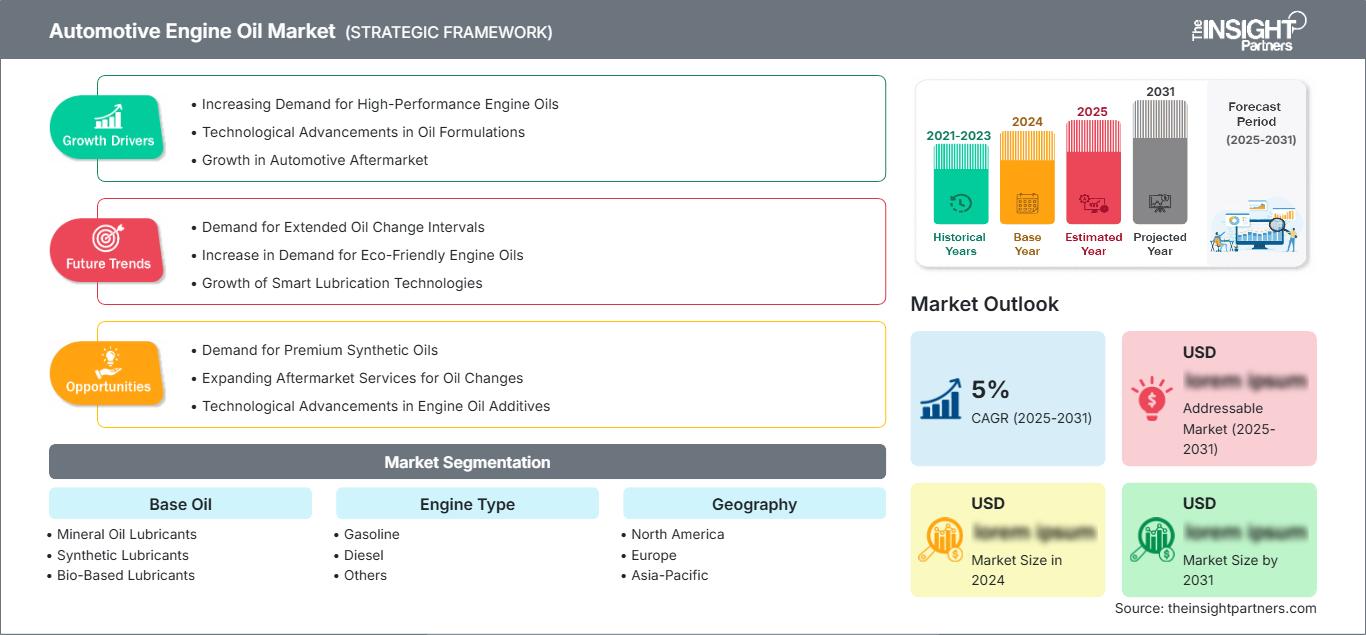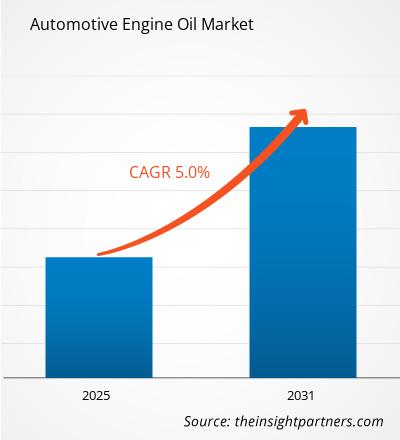Se espera que el mercado de aceite para motores automotrices registre una CAGR del 5% entre 2025 y 2031, con un tamaño de mercado que se expandirá de US$ XX millones en 2024 a US$ XX millones en 2031.
El informe está segmentado por aceite base (lubricantes minerales, sintéticos y de base biológica). Además, presenta un análisis por tipo de motor (gasolina, diésel y otros). El informe, según el tipo de vehículo, se segmenta en vehículos de pasajeros, vehículos comerciales ligeros (LCV), vehículos comerciales pesados, vehículos de dos ruedas y otros. El análisis global se desglosa por región y por país principal. El informe ofrece el valor en USD de los análisis y segmentos mencionados.
Propósito del Informe
El informe "Mercado de Aceites para Motores Automotrices" de The Insight Partners busca describir el panorama actual y el crecimiento futuro, los principales factores impulsores, los desafíos y las oportunidades. Esto proporcionará información a diversas partes interesadas del negocio, como:
- Proveedores/fabricantes de tecnología: Para comprender la dinámica cambiante del mercado y conocer las oportunidades potenciales de crecimiento, lo que les permitirá tomar decisiones estratégicas informadas.
- Inversores: Realizar un análisis exhaustivo de tendencias respecto a la tasa de crecimiento del mercado, las proyecciones financieras del mercado y las oportunidades que existen en toda la cadena de valor.
- Órganos reguladores: Regular las políticas y las actividades policiales en el mercado con el objetivo de minimizar el abuso, preservar la confianza de los inversores y defender la integridad y estabilidad del mercado.
Segmentación del mercado de aceites para motores automotrices
Aceite base
- Lubricantes de aceite mineral
- Lubricantes sintéticos
- Lubricantes de base biológica
Tipo de motor
- Gasolina
- Diesel
- Otros
Obtendrá personalización en cualquier informe, sin cargo, incluidas partes de este informe o análisis a nivel de país, paquete de datos de Excel, así como también grandes ofertas y descuentos para empresas emergentes y universidades.
Mercado de aceites para motores de automoción: Perspectivas estratégicas

- Obtenga las principales tendencias clave del mercado de este informe.Esta muestra GRATUITA incluirá análisis de datos, desde tendencias del mercado hasta estimaciones y pronósticos.
Factores que impulsan el crecimiento del mercado de aceites para motores automotrices
- Demanda creciente de aceites de motor de alto rendimiento: La creciente demanda de aceites de alto rendimiento, en particular los sintéticos, se debe a la necesidad de una mejor protección del motor, una mayor eficiencia de combustible y intervalos de servicio más largos. Los motores modernos, especialmente en vehículos de lujo y de alto rendimiento, requieren aceites de motor premium que cumplan con estándares específicos de rendimiento y durabilidad.
- Avances tecnológicos en formulaciones de aceites: Los aceites de motor para automóviles se están especializando cada vez más, con avances en aceites sintéticos y semisintéticos que ofrecen propiedades de lubricación superiores, intervalos de cambio de aceite más largos y una mayor protección del motor. Innovaciones como los aceites de alto kilometraje y los aceites diseñados para tipos de motor específicos impulsan aún más el mercado.
- Crecimiento del mercado de repuestos automotrices: La industria de repuestos automotrices es un motor clave del crecimiento de los aceites de motor. Con el creciente número de vehículos en circulación, la demanda de cambios regulares de aceite de motor y la creciente popularidad del mantenimiento de automóviles por cuenta propia están impulsando el mercado de aceites de motor para automóviles. Además, los servicios de cambio de aceite en los talleres mecánicos contribuyen aún más al crecimiento del mercado.
Tendencias futuras del mercado de aceites para motores automotrices
- Demanda de intervalos de cambio de aceite más largos: A medida que los motores de los vehículos se vuelven más eficientes y avanzados, los consumidores buscan cada vez más aceites de motor con intervalos de servicio más largos. Se espera que los aceites sintéticos, que ofrecen mayor estabilidad y longevidad, dominen el mercado, ya que reducen los costos de mantenimiento y mejoran el rendimiento del motor con el tiempo.
- Aumento de la demanda de aceites de motor ecológicos: El futuro del mercado de aceites de motor probablemente incluirá formulaciones más respetuosas con el medio ambiente, incluyendo aceites biodegradables y derivados de fuentes renovables. La preocupación por el medio ambiente y la búsqueda de la sostenibilidad impulsan a los fabricantes a desarrollar aceites menos dañinos para los ecosistemas y que reduzcan la huella de carbono.
- Crecimiento de las tecnologías de lubricación inteligente: La integración de sensores inteligentes y tecnología IoT en los sistemas vehiculares probablemente impulsará la demanda de aceites de motor más inteligentes que proporcionen información en tiempo real sobre el estado del aceite, mejorando la eficiencia de los cambios de aceite y optimizando los programas de mantenimiento del vehículo. Estos aceites pueden ayudar a optimizar el rendimiento del motor, a la vez que reducen los residuos y los costos operativos.
Oportunidades del mercado de aceites para motores automotrices
- Demanda de aceites sintéticos premium: A medida que los consumidores y fabricantes de vehículos buscan un mayor rendimiento, la demanda de aceites de motor sintéticos premium seguirá creciendo. Estos aceites ofrecen una protección superior, mayor eficiencia de combustible e intervalos de servicio más largos, lo que los posiciona como la opción preferida en el mercado de motores modernos y vehículos de alto rendimiento.
- Expansión de los servicios posventa para cambios de aceite: La expansión global del sector de servicios posventa representa una oportunidad de crecimiento para las empresas de aceites de motor. A medida que aumenta la propiedad de vehículos, especialmente en las economías en desarrollo, aumentará la necesidad de cambios de aceite y servicios de mantenimiento regulares, lo que impulsará la demanda de aceites de motor para automóviles en el mercado posventa.
- Avances tecnológicos en aditivos para aceites de motor: Las innovaciones en aditivos para aceites de motor, como las que mejoran el ahorro de combustible, reducen las emisiones y ofrecen una protección antidesgaste avanzada, generan oportunidades en el mercado de aceites de motor. La creciente preferencia de los consumidores por aceites de alto rendimiento y mayor duración que se adapten a los motores modernos impulsa la demanda de estos aceites tecnológicamente avanzados.
Perspectivas regionales del mercado de aceites para motores automotrices
Los analistas de The Insight Partners han explicado detalladamente las tendencias regionales y los factores que influyen en el mercado de aceites para motores automotrices durante el período de pronóstico. Esta sección también analiza los segmentos y la geografía del mercado de aceites para motores automotrices en América del Norte, Europa, Asia Pacífico, Oriente Medio y África, y América del Sur y Central.
Alcance del informe del mercado de aceites para motores automotrices
| Atributo del informe | Detalles |
|---|---|
| Tamaño del mercado en 2024 | US$ XX millones |
| Tamaño del mercado en 2031 | US$ XX millones |
| CAGR global (2025-2031) | 5% |
| Datos históricos | 2021-2023 |
| Período de pronóstico | 2025-2031 |
| Segmentos cubiertos | Por aceite base
|
| Regiones y países cubiertos | América del norte
|
| Líderes del mercado y perfiles de empresas clave |
|
Densidad de actores del mercado de aceites de motor para automóviles: comprensión de su impacto en la dinámica empresarial
El mercado de aceites de motor para automóviles está creciendo rápidamente, impulsado por la creciente demanda del usuario final debido a factores como la evolución de las preferencias de los consumidores, los avances tecnológicos y un mayor conocimiento de los beneficios del producto. A medida que aumenta la demanda, las empresas amplían su oferta, innovan para satisfacer las necesidades de los consumidores y aprovechan las tendencias emergentes, lo que impulsa aún más el crecimiento del mercado.

- Obtenga una descripción general de los principales actores clave del mercado de aceite para motores automotrices
Puntos clave de venta
- Cobertura integral: el informe cubre de manera integral el análisis de productos, servicios, tipos y usuarios finales del mercado de aceite de motor automotriz, proporcionando un panorama holístico.
- Análisis de expertos: el informe se compila con base en el conocimiento profundo de expertos y analistas de la industria.
- Información actualizada: El informe asegura relevancia comercial debido a su cobertura de información reciente y tendencias de datos.
- Opciones de personalización: este informe se puede personalizar para satisfacer los requisitos específicos del cliente y adaptarse adecuadamente a las estrategias comerciales.
Por lo tanto, el informe de investigación sobre el mercado de aceites para motores automotrices puede ayudar a descifrar y comprender el panorama de la industria y sus perspectivas de crecimiento. Si bien existen algunas preocupaciones válidas, las ventajas generales de este informe suelen superar las desventajas.
- Análisis histórico (2 años), año base, pronóstico (7 años) con CAGR
- Análisis PEST y FODA
- Tamaño del mercado, valor/volumen: global, regional y nacional
- Industria y panorama competitivo
- Conjunto de datos de Excel
Informes recientes
Informes relacionados
Testimonios
Razón para comprar
- Toma de decisiones informada
- Comprensión de la dinámica del mercado
- Análisis competitivo
- Información sobre clientes
- Pronósticos del mercado
- Mitigación de riesgos
- Planificación estratégica
- Justificación de la inversión
- Identificación de mercados emergentes
- Mejora de las estrategias de marketing
- Impulso de la eficiencia operativa
- Alineación con las tendencias regulatorias




















 Obtenga una muestra gratuita para - Mercado de aceites para motores automotrices
Obtenga una muestra gratuita para - Mercado de aceites para motores automotrices